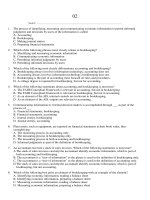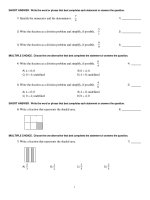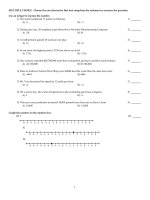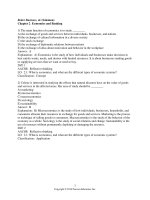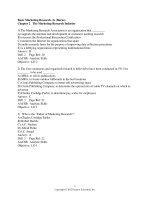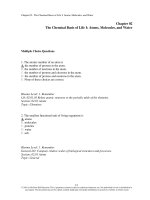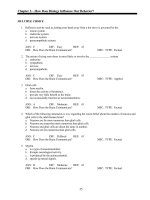Better business 3rd edition solomon test bank
Bạn đang xem bản rút gọn của tài liệu. Xem và tải ngay bản đầy đủ của tài liệu tại đây (384.17 KB, 44 trang )
Better Business, 3e (Solomon)
Chapter 2 Economics and Banking
1) The main function of economics is to study ________.
A) the exchange of goods and services between individuals, businesses, and nations
B) the exchange of cultural information in a diverse society
C) the stock exchange
D) the exchange of diplomatic relations between nations
E) the exchange of ideas about motivation and behavior in the workplace
Answer: A
Explanation: A) Economics is the study of how individuals and businesses make decisions to
best satisfy wants, needs, and desires with limited resources. It is about businesses making goods
or supplying services that we want or need to buy.
Diff: 1
AACSB: Reflective Thinking
Objective: 2-1 What is economics, and what are the different types of economic systems?
Classification: Conceptual
2) Celeste is interested in studying the effects that natural disasters have on the value of goods
and services in the affected areas. Her area of study should be ________.
A) marketing
B) microeconomics
C) macroeconomics
D) sociology
E) sustainability
Answer: B
Explanation: B) Microeconomics is the study of how individuals, businesses, households, and
consumers allocate their resources in exchange for goods and services. Marketing is the process
or technique of selling goods to consumers. Macroeconomics is the study of the behavior of the
economy as a whole. Sociology is the study of social relations and change.
Diff: 2
AACSB: Reflective Thinking
Objective: 2-1 What is economics, and what are the different types of economic systems?
Classification: Application
1
Copyright © 2014 Pearson Education, Inc.
3) Joseph took a class in macroeconomics, which means that he was studying the behavior of
________.
A) individual businesses
B) people with limited resources
C) the overall economy
D) corporate executives
E) Fortune 500 companies
Answer: C
Explanation: C) Macroeconomics is the study of the behavior of the economy as a whole. The
study of behavior of individual businesses, people with limited resources, and corporate
executives would fall under the area of microeconomics.
Diff: 1
AACSB: Reflective Thinking
Objective: 2-1 What is economics, and what are the different types of economic systems?
Classification: Conceptual
4) A free market economy is one in which ________.
A) the government or other centralized group determines what to produce
B) individuals determine what to produce with some level of government involvement
C) a tightly knit social network barters and trades for goods at a market
D) individuals and private firms make decisions based on consumer needs and wants
E) privately owned, profit-seeking enterprises are converted to government-owned production
and services
Answer: D
Explanation: D) A market economy is run entirely by individuals and businesses with no
government involvement. Responses A) refers to a planned economy; B) to a mixed economy;
and C) to a traditional economy.
Diff: 1
AACSB: Reflective Thinking
Objective: 2-1 What is economics, and what are the different types of economic systems?
Classification: Conceptual
Learning Outcome: Compare and contrast different economic systems
2
Copyright © 2014 Pearson Education, Inc.
5) A mixed economy is one in which ________.
A) both resources and means of production are extremely limited and generally confined to
agricultural produce
B) the government or other centralized group determines and controls all resources and means of
production
C) both individuals and government control resources and determine production methods
D) either individuals or private firms control resources and determine production methods
E) there is no government intervention whatsoever in industry
Answer: C
Explanation: C) A mixed economy is one in which individuals, businesses, and government
share responsibility for determining allocation of resources and methods of production.
Responses A) refers to a traditional economy; B) to a planned economy; and D) to a market
economy.
Diff: 1
AACSB: Reflective Thinking
Objective: 2-1 What is economics, and what are the different types of economic systems?
Classification: Conceptual
Learning Outcome: Compare and contrast different economic systems
6) A planned economy is one in which ________.
A) the government or other centralized group determines wages, sets prices, and distributes
resources and products to the common group
B) individuals produce enough for personal survival with few resources or goods left over to
trade or barter
C) individual income ultimately controls purchasing decisions
D) government distributes some goods and services through selected social programs, and
individual income determines purchasing decisions for other goods and services
E) the production and pricing of goods and services is determined through the operation of a
market
Answer: A
Explanation: A) A planned economy is one in which the government controls the distribution of
goods and resources. Responses B) refers to a traditional economy; C) to a market economy; and
D) to a mixed economy
Diff: 1
AACSB: Reflective Thinking
Objective: 2-1 What is economics, and what are the different types of economic systems?
Classification: Conceptual
Learning Outcome: Compare and contrast different economic systems
3
Copyright © 2014 Pearson Education, Inc.
7) John is an employee at a car manufacturer. Today he has come into work to find that
production has stopped because the government has determined that the steel used in the cars
will be better used in the manufacture of a new railway line. John doesn't mind, because although
his wages are low, he gets paid whether there is any work for him to do or not. John MOST
likely lives in a ________.
A) traditional economy
B) planned economy
C) market economy
D) mixed economy
E) capitalist economy
Answer: B
Explanation: B) In a planned economy, government determines what to produce, controls the
resources and means of production, and determines wages. Resources and products are
distributed to the common group.
Diff: 2
AACSB: Analytic Skills
Objective: 2-1 What is economics, and what are the different types of economic systems?
Classification: Application
Learning Outcome: Compare and contrast different economic systems
8) Socialism is similar to communism in that ________.
A) the government provides all of the social services
B) the governments fail under economic stress
C) the government distributes goods and services
D) the government experiences shortages of goods and services
E) the government does not intervene in industry
Answer: C
Explanation: C) In both socialist and communist states, the government is responsible for
distributing both goods and services. However, in a communist state, the entire responsibility for
the distribution is in the hands of the government, whereas in a socialist state, the government
traditionally runs some of the social services and utilities but also allows for some private
enterprise.
Diff: 1
AACSB: Analytic Skills
Objective: 2-1 What is economics, and what are the different types of economic systems?
Classification: Application
Learning Outcome: Compare and contrast different economic systems
4
Copyright © 2014 Pearson Education, Inc.
9) Which of the following statements is NOT true of a market economy?
A) The pricing of goods is determined by what sellers wish to charge and buyers wish to pay.
B) The system encourages private ownership of resources.
C) The individual makes his or her own economic decisions.
D) The government may supply some goods or services
E) The economy is defined by a freedom of choice for both buyers and sellers.
Answer: D
Explanation: D) In a free market economy, the government does not intervene in the production
of goods or services. Most modern economies, including that of the U.S., are mixed economies
of privately owned businesses and some government control of social services.
Diff: 2
AACSB: Reflective Thinking
Objective: 2-1 What is economics, and what are the different types of economic systems?
Classification: Conceptual
Learning Outcome: Compare and contrast different economic systems
10) ________ is one of the countries closest to having a planned economy, and ________ is one
of the countries closest to having a market economy.
A) Russia; Singapore
B) India; Norway
C) Russia; Norway
D) Cuba; Singapore
E) Canada; China
Answer: D
Explanation: D) According to Figure 2.1, Cuba is at the end of the spectrum closest to a planned
economy, and Singapore is at the end of the spectrum closest to a market economy.
Diff: 1
AACSB: Reflective Thinking
Objective: 2-1 What is economics, and what are the different types of economic systems?
Classification: Conceptual
Learning Outcome: Compare and contrast different economic systems
5
Copyright © 2014 Pearson Education, Inc.
11) Which transaction best describes bartering?
A) an exchange of goods for currency, in which the price of something is determined by
establishing its value against an underlying commodity
B) a transfer of goods without an exchange of currency, in which the price of something is
determined by the seller, and the buyer agrees to pay at a later time
C) an exchange of goods without an exchange of currency, in which the price of something is
determined by the needs and resources of each person involved in the exchange
D) an exchange of goods for currency, in which the price of something is determined by what
buyers are willing to pay
E) an exchange of currency without an exchange of goods, in which the price of something is
determined by what sellers demand
Answer: C
Explanation: C) The barter system involved a trading of goods without an exchange of money
where the price was determined by the needs and resources of each person taking part in the
exchange. Response A) refers to the use of currency in a transaction in which the price of an item
depends on its value relative to a consistent standard; Response B) to a transaction involving
credit; and Response D) to a transaction in which the price is set by the law of demand.
Diff: 2
AACSB: Analytic Skills
Objective: 2-2 What are the principles of supply and demand and the factors that affect each
principle?
Classification: Conceptual
12) Mae's Country Kitchen sells out of her cinnamon rolls every morning before 8:30 a.m., and
her later customers ask her to make more. The next day, Mae makes an additional two dozen
cinnamon rolls and raises the price of an individual cinnamon roll by 50¢. She sells all but one of
them. Mae has found the ________ price of her cinnamon rolls.
A) market
B) supply
C) demand
D) determinant
E) surplus
Answer: A
Explanation: A) The market price is the price at which everyone who wants the item can get it
without surplus or further demand.
Diff: 2
AACSB: Analytic Skills
Objective: 2-2 What are the principles of supply and demand and the factors that affect each
principle?
Classification: Application
Learning Outcome: Discuss strategies for setting and adjusting prices
6
Copyright © 2014 Pearson Education, Inc.
13) The amount of a product or service that is available for purchase at any given time is called
________.
A) commodity
B) surplus
C) supply
D) demand
E) shortage
Answer: C
Explanation: C) Supply is the amount of a product or service available; commodities are
particular economic goods; a surplus is the amount of supply over the demand; demand is the
need for an item.
Diff: 1
AACSB: Reflective Thinking
Objective: 2-2 What are the principles of supply and demand and the factors that affect each
principle?
Classification: Conceptual
14) Prices become higher when a unique and highly desirable item is auctioned ________.
A) because the supply and demand are equal
B) because the demand is higher than the supply
C) because the supply is higher than the demand
D) because the supply and demand are kept unknown
E) because the demand is lower than the supply
Answer: B
Explanation: B) Prices increase depending on demand, therefore, the greater the demand the
higher the price. If similar or identical items are offered for auction, there is less demand,
therefore, the selling price is likely to be lower than for the unique and highly desirable item.
Diff: 1
AACSB: Reflective Thinking
Objective: 2-2 What are the principles of supply and demand and the factors that affect each
principle?
Classification: Conceptual
7
Copyright © 2014 Pearson Education, Inc.
15) According to the law of supply, the amount of a good or service supplied will increase as the
price increases, and decrease as the price decreases. This direct relationship exists because
________.
A) supply is not dependent on the resources required to produce the product
B) supply is derived from a producer's desire to maximize profit
C) supply is affected by the number of suppliers
D) supply is not affected by the quantity of similar or substitute products
E) supply is affected by changes in technology
Answer: B
Explanation: B) All else held constant, supply is derived from a producer's desire to maximize
profits. The more money a business can get for its good or service, the more of its product it is
willing to supply.
Diff: 2
AACSB: Analytic Skills
Objective: 2-2 What are the principles of supply and demand and the factors that affect each
principle?
Classification: Application
16) A supply curve illustrates ________.
A) that as supply decreases, demand decreases
B) the effects of price on quantity supplied
C) the effects of price on quantity demanded
D) that as supply increases, the price stays the same
E) the effects of changes in resource prices on supply
Answer: B
Explanation: B) Supply curves illustrate that supply increases as prices increase.The more a
supplier can charge for a product, the more of that product he will want to supply.
Diff: 1
AACSB: Reflective Thinking
Objective: 2-2 What are the principles of supply and demand and the factors that affect each
principle?
Classification: Conceptual
8
Copyright © 2014 Pearson Education, Inc.
17) ________ refers to how much of a product or service people want to buy at any given time.
A) Commodity
B) Surplus
C) Supply
D) Demand
E) Equilibrium
Answer: D
Explanation: D) Demand refers to how much of a product or service people want to buy at any
given time. Commodities are particular economic goods. A surplus is the amount of supply that
exceeds market demand; supply is the amount of the item available.
Diff: 1
AACSB: Reflective Thinking
Objective: 2-2 What are the principles of supply and demand and the factors that affect each
principle?
Classification: Conceptual
18) A demand curve illustrates ________.
A) the effects of price on quantity demanded
B) that as price increases, demand stays the same
C) the effects of supply on quantity demanded
D) that as demand decreases, the price increases
E) the effects on population changes on demand
Answer: A
Explanation: A) Demand curves illustrate that demand increases as prices decrease by showing
the relationship between price and quantity demanded.
Diff: 1
AACSB: Reflective Thinking
Objective: 2-2 What are the principles of supply and demand and the factors that affect each
principle?
Classification: Conceptual
9
Copyright © 2014 Pearson Education, Inc.
19) When the supply curve and the demand curve for a single product or service are shown on
the same graph, the point at which the curves intersect identifies the ________.
A) total profit earned by the producers
B) market price of the good
C) quality of the good or service being purchased
D) amount of the surplus to be anticipated
E) the number of substitute goods available
Answer: B
Explanation: B) The market price of an item is the price at which supply equals demand.
Therefore, the market price is the point at which the supply curve and the demand curve
intersect.
Diff: 1
AACSB: Reflective Thinking
Objective: 2-2 What are the principles of supply and demand and the factors that affect each
principle?
Classification: Conceptual
20) Taken together, iPod and iTunes are ________.
A) substitute goods
B) complementary goods
C) competitive goods
D) monopolistic goods
E) intangible goods
Answer: B
Explanation: B) Products or services that go with each other and are consumed together, such as
the iPod and iTunes, are considered complementary goods. The demand for iTunes is great as
long as consumers are buying and using iPods and other portable media devices. These two
products do not substitute for or compete with one another. Apple, their manufacturer, is
successful in the market, but is not a monopoly, since there are substitute produces that
consumers may choose to purchase.
Diff: 1
AACSB: Reflective Thinking
Objective: 2-2 What are the principles of supply and demand and the factors that affect each
principle?
Classification: Conceptual
10
Copyright © 2014 Pearson Education, Inc.
21) Pilar's daughter wants a Betty the Builder doll for Christmas. When Pilar gets to the toy store
they are sold out, so she goes to another store. There she is told that they have a limited quantity,
which will go on special sale at 6 a.m. the next morning—and that she'd better get in line early.
This is an example of which of the following determinants of demand?
A) complementary goods
B) population changes
C) substitute goods
D) consumer preference
E) changes in income levels
Answer: D
Explanation: D) Consumer preference drives demand by increasing popularity of the item.
Diff: 1
AACSB: Reflective Thinking
Objective: 2-2 What are the principles of supply and demand and the factors that affect each
principle?
Classification: Conceptual
22) One example of complementary goods is ________.
A) cheese and crackers
B) cable television and Internet service
C) dog food and a dog bowl
D) a cell phone and wireless phone service
E) magazines and newspapers
Answer: D
Explanation: D) Complementary goods go with each other and are consumed together, and if
new technology renders one obsolete, the demand for the other goes down.Although cable TV
and Internet may be consumed at the same time and are often bundled together by service
providers, neither is necessary to the operation of the other. The other choices are inaccurate
because, though they describe items that go with each other and are consumed together, the
obsolescence of one does not lead to less demand of the other.
Diff: 1
AACSB: Reflective Thinking
Objective: 2-2 What are the principles of supply and demand and the factors that affect each
principle?
Classification: Conceptual
11
Copyright © 2014 Pearson Education, Inc.
23) What are substitute goods?
A) goods that can be used in place of others
B) goods that can be modified to replace others
C) goods that complement others
D) goods that can be used to repair others
E) goods that experience seasonal changes in demand
Answer: A
Explanation: A) Substitute goods can be used in place of others, such as cola-type soft drinks
Coke or Pepsi.
Diff: 1
AACSB: Reflective Thinking
Objective: 2-2 What are the principles of supply and demand and the factors that affect each
principle?
Classification: Conceptual
24) What best determines the level of competition?
A) the degree of population change
B) the number of substitutes for a certain good or service
C) the degree of change in income levels
D) the number of complementary products or service
E) the existence of complementary goods
Answer: B
Explanation: B) Competition is driven by substitute goods and services, one of the factors of
demand. The greater the number of substitute products, the more competition a product faces.
Diff: 2
AACSB: Reflective Thinking
Objective: 2-3 What are the various degrees of competition?
Classification: Conceptual
25) ________ occurs when there is only one provider of a service or product and no substitutes
for the service or product exist.
A) A duopoly
B) A monopoly
C) An oligopoly
D) Perfect competition
E) Monopolistic competition
Answer: B
Explanation: B) True monopolies are rare and the FTC regulates business mergers carefully to
prevent the formation of monopolies.
Diff: 1
AACSB: Reflective Thinking
Objective: 2-3 What are the various degrees of competition?
Classification: Conceptual
12
Copyright © 2014 Pearson Education, Inc.
26) The ________ and the Department of Justice must review mergers between large
competitors to determine whether the combined firm would be a monopolistic corporation.
A) Federal Trade Commission
B) Internal Revenue Service
C) Federal Reserve Bank
D) Federal Appeals Court
E) Securities and Exchange Commission
Answer: A
Explanation: A) Federal Trade Commission and the Department of Justice review proposed
mergers to ensure that such a merger would not be disadvantageous to consumers. The IRS,
Federal Reserve Bank, the Federal Appeals Court, and the Securities and Exchange Commission
are not charged with evaluating proposed mergers to determine the potential impact on
consumers.
Diff: 1
AACSB: Reflective Thinking
Objective: 2-3 What are the various degrees of competition?
Classification: Conceptual
Learning Outcome: Discuss the functions of different types of financial institutions in the
monetary system
27) The government allows ________ companies to operate as regulated monopolies.
A) airline
B) mining
C) utility
D) timber
E) telecommunications
Answer: C
Explanation: C) Utility companies are often permitted to operate as regulated monopolies
because they deal with limited supplies of resources like water. However, although they are
allowed to run as monopolies, the government will regulate their prices to ensure that they do not
inflate prices.
Diff: 1
AACSB: Reflective Thinking
Objective: 2-3 What are the various degrees of competition?
Classification: Conceptual
13
Copyright © 2014 Pearson Education, Inc.
28) What is the MOST likely scenario in a monopoly, where only one seller supplies a product or
service?
A) Demand may be low.
B) Demand may vary.
C) Supply may be abundant.
D) Supply may be limited.
E) Prices will be low.
Answer: D
Explanation: D) Supply may be limited, potentially increasing cost of products to consumers
Diff: 1
AACSB: Reflective Thinking
Objective: 2-3 What are the various degrees of competition?
Classification: Conceptual
29) ________ occurs when there are a few sellers in a given market and each seller has a fairly
large share of that market.
A) Monopolistic competition
B) A monopoly
C) An oligopoly
D) Perfect competition
E) A duopoly
Answer: C
Explanation: C) An oligopoly is a competition in which only a few sellers exist.
Diff: 1
AACSB: Reflective Thinking
Objective: 2-3 What are the various degrees of competition?
Classification: Conceptual
30) Which of the following industries is LEAST likely to form an oligopoly?
A) airline
B) automobile
C) tobacco
D) consulting
E) pharmaceutical
Answer: D
Explanation: D) Typically, oligopolies occur in industries in which there is a high investment to
enter, so oligopolies are often major corporations in certain areas such as the airline, automobile,
high-tech, pharmaceutical, and tobacco industries. Because consulting is knowledge intensive
rather than resource intensive, it is least likely to become part of an oligopoly.
Diff: 1
AACSB: Reflective Thinking
Objective: 2-3 What are the various degrees of competition?
Classification: Conceptual
14
Copyright © 2014 Pearson Education, Inc.
31) ________ occurs when there are many buyers and sellers and little differentiation between
products, but perceived differences between products among consumers.
A) Monopolistic competition
B) A monopoly
C) An oligopoly
D) Perfect competition
E) A duopoly
Answer: A
Explanation: A) Monopolistic competition occurs when there are many buyers and sellers and
little differentiation between the products themselves (e.g. coffee versus coffee), but there is a
perceived difference among consumers, who thereby favor one product offering over another.
Diff: 1
AACSB: Reflective Thinking
Objective: 2-3 What are the various degrees of competition?
Classification: Conceptual
32) In what way does monopolistic competition favor consumers?
A) A limited number of sellers differentiate their products or services by offering better quality
items and/or greater incentives to purchase them.
B) A large number of sellers providing virtually identical products means that no single seller
can set the price.
C) A large number of sellers and products increases supply of similar, but not identical, products
and services, so to increase demand sellers are likely to reduce prices.
D) A single seller or provider ensures consistency of product quality and regulated pricing.
E) A large number of sellers of virtually identical products means that no single seller can set the
price for these products.
Answer: C
Explanation: C) Monopolistic competition is characterized by a market in which there are a
large number of sellers providing similar goods to consumers whose purchasing choices are
based on perceived differences between them. Price is often the distinction.
Diff: 2
AACSB: Analytic Skills
Objective: 2-3 What are the various degrees of competition?
Classification: Application
15
Copyright © 2014 Pearson Education, Inc.
33) ________ occurs when there are many buyers and sellers of products that are virtually
identical and any seller can easily enter and exit the market.
A) Monopolistic competition
B) A monopoly
C) An oligopoly
D) A duopoly
E) Perfect competition
Answer: E
Explanation: E) Perfect competition occurs when there are many buyers and sellers of products
that are virtually identical and any seller can easily enter and exit the market. When these
conditions exist, no single supplier can influence the price.
Diff: 1
AACSB: Reflective Thinking
Objective: 2-3 What are the various degrees of competition?
Classification: Conceptual
34) What is the purpose of the U.S. government's regulation of monopolies?
A) to ensure that there are as many opportunities for perfect competition as possible
B) to ensure that no single seller can drastically increase the price of a given product or service
C) to ensure that no one industry has control of the entire national economy
D) to ensure that local businesses are always the preferred provider of products consumers want
E) to ensure that companies have equal access to natural resources like water and natural gas
Answer: B
Explanation: B) Formation of monopolies is regulated so that a potential monopolistic supplier
can not charge an excessive price or be unresponsive to consumer needs. In the United States, as
well as in other countries, large monopolies are rarely allowed. Natural monopolies are an
exception. Utility companies, such as those that sell natural gas or water to consumers, may be
permitted to hold monopolies in an effort to conserve natural resources.
Diff: 1
AACSB: Reflective Thinking
Objective: 2-3 What are the various degrees of competition?
Classification: Conceptual
16
Copyright © 2014 Pearson Education, Inc.
35) What is an economic indicator?
A) a business expert who understands the economy and can advise managers how best to handle
their companies
B) a formula used by accountants to determine their company's net profit
C) an aspect of the economy that can be measured in order to determine a country's overall
economic health
D) a way of identifying whether a given market is an oligopoly or monopolistic competition
E) an action taken by the government to influence swings in the business cycle
Answer: C
Explanation: C) Economic indicators are used to determine how well businesses are performing
overall.
Diff: 1
AACSB: Reflective Thinking
Objective: 2-4 How do economic indicators—particularly the gross domestic product (GDP),
price indices, the unemployment rate, and productivity—reflect economic health?
Classification: Conceptual
Learning Outcome: Explain how economic performance is monitored
36) The gross domestic product (GDP) measures ________.
A) the overall market value of final goods and services produced in a country in a given year
B) the overall gross profit a country earns in a given year
C) a country's overall income resulting from production in a year
D) a country's overall expenditures in a given year
E) a country's overall increase in profitability from one year to the next
Answer: A
Explanation: A) GDP measures market value of all goods and services produced in a country,
including goods and services produced by foreign-owned companies that operate in the country.
Diff: 1
AACSB: Reflective Thinking
Objective: 2-4 How do economic indicators—particularly the gross domestic product (GDP),
price indices, the unemployment rate, and productivity—reflect economic health?
Classification: Conceptual
Learning Outcome: Explain how economic performance is monitored
17
Copyright © 2014 Pearson Education, Inc.
37) ArmiLiza, a popular United States-based brand of handbags, has built a second factory in
Mexico. The majority of the new factory's employees are Mexican citizens or Honduran
immigrants. On which country's gross domestic product will the second factory's goods be
counted?
A) the United States
B) Mexico
C) Honduras
D) They will be split between the United States and Mexico.
E) They will be split among all three countries.
Answer: B
Explanation: B) GDP measures market value of all goods and services produced in a country,
including goods and services produced by foreign-owned companies.
Diff: 2
AACSB: Reflective Thinking
Objective: 2-4 How do economic indicators—particularly the gross domestic product (GDP),
price indices, the unemployment rate, and productivity—reflect economic health?
Classification: Conceptual
Learning Outcome: Explain how economic performance is monitored
38) The ________ is the most widely used indicator of economic growth in the world today.
A) gross national product
B) consumer price index
C) producer price index
D) gross domestic product
E) unemployment rate
Answer: D
Explanation: D) Most countries use the GDP to measure their economic health.
Diff: 1
AACSB: Reflective Thinking
Objective: 2-4 How do economic indicators—particularly the gross domestic product (GDP),
price indices, the unemployment rate, and productivity—reflect economic health?
Classification: Conceptual
Learning Outcome: Explain how economic performance is monitored
18
Copyright © 2014 Pearson Education, Inc.
39) The gross national product (GNP) measures ________.
A) the overall market value of final goods and services produced in a country in a year
B) the overall gross profit a country earns in a year
C) a country's overall income resulting from production in a year
D) a country's overall expenditures in a given year
E) a country's overall increase in profitability from one year to the next
Answer: C
Explanation: C) The GNP attributes earnings to the country where the company is owned, not
where the product was manufactured. Therefore, Toshiba television sets made in Tennessee
would be included in Japan's GNP, Toshiba's home country.
Diff: 1
AACSB: Reflective Thinking
Objective: 2-4 How do economic indicators—particularly the gross domestic product (GDP),
price indices, the unemployment rate, and productivity—reflect economic health?
Classification: Conceptual
Learning Outcome: Explain how economic performance is monitored
40) A rise in the general level of prices over time is called ________.
A) deflation
B) inflation
C) disinflation
D) deflection
Answer: B
Explanation: B) Inflation is a rise in the general level of prices over time. Deflation is a decrease
in general level of prices over time. Disinflation is a decrease in the rate of inflation over time.
Deflection is not an economic term.
Diff: 1
AACSB: Reflective Thinking
Objective: 2-4 How do economic indicators—particularly the gross domestic product (GDP),
price indices, the unemployment rate, and productivity—reflect economic health?
Classification: Conceptual
19
Copyright © 2014 Pearson Education, Inc.
41) ________ is a decrease in the rate of inflation.
A) Deflation
B) Inflation
C) Disinflation
D) Deflection
E) Depression
Answer: C
Explanation: C) By definition, disinflation is a decrease in the rate of inflation over time.
Diff: 1
AACSB: Reflective Thinking
Objective: 2-4 How do economic indicators—particularly the gross domestic product (GDP),
price indices, the unemployment rate, and productivity—reflect economic health?
Classification: Conceptual
Learning Outcome: Explain how economic performance is monitored
42) A continuous decrease in the level of prices over time is called ________.
A) deflation
B) inflation
C) disinflation
D) deflection
E) depression
Answer: A
Explanation: A) By definition, deflation is a decrease in general level of prices over time.
Diff: 1
AACSB: Reflective Thinking
Objective: 2-4 How do economic indicators—particularly the gross domestic product (GDP),
price indices, the unemployment rate, and productivity—reflect economic health?
Classification: Conceptual
Learning Outcome: Explain how economic performance is monitored
20
Copyright © 2014 Pearson Education, Inc.
43) What does the monthly consumer price index (CPI) measure?
A) the changes in prices of goods and services as determined by the sellers
B) the amount of products and services manufactured domestically
C) the number of new products purchased by consumers
D) the changes in prices of goods and services purchased by households
E) the changes in prices of the resources used to create consumer goods
Answer: D
Explanation: D) CPI is a benchmark used to track changes over a period of time in the price of
goods and services that consumers purchase. The CPI measures price changes by creating a
"market basket" of a specified set of goods and services that represent the average buying pattern
of urban households. The value of this market basket is determined by the combined prices of
these goods and services and is compared to its value in a prior period (generally a month), and
the change is noted.
Diff: 1
AACSB: Reflective Thinking
Objective: 2-4 How do economic indicators—particularly the gross domestic product (GDP),
price indices, the unemployment rate, and productivity—reflect economic health?
Classification: Conceptual
Learning Outcome: Explain how economic performance is monitored
44) The value of the CPI's "market basket" is determined by ________.
A) the combined prices of a specified set of goods and services, including taxes
B) the net profit earned by businesses selling a specified set of goods and services
C) the price of all goods and services, including taxes, purchased in a particular period
D) the cost of production for a specified set of goods and services in a given market
E) the difference between the prices of the raw materials used to create goods and the prices the
consumer actually pays for these finished goods
Answer: A
Explanation: A) The value of the market basket is determined by the prices of a certain set of
goods and services, including taxes. The value of the market basket in a given period (e.g., a
month) is then compared to its value in a prior period.
Diff: 1
AACSB: Reflective Thinking
Objective: 2-4 How do economic indicators—particularly the gross domestic product (GDP),
price indices, the unemployment rate, and productivity—reflect economic health?
Classification: Conceptual
Learning Outcome: Explain how economic performance is monitored
21
Copyright © 2014 Pearson Education, Inc.
45) Why does the U.S. Bureau of Labor Statistics evaluate the CPI's "market basket"?
A) to ensure that it reflects current trends in the production of goods and services
B) to ensure that it reflects current consumer spending habits
C) to ensure that it reflects current wholesale spending habits
D) to ensure that it reflects current consumer demand
E) to ensure that it reflects current wholesale resource costs
Answer: B
Explanation: B) The Bureau of Labor Statistics evaluates the market basket as a way to track
spending habits of many different families and thus get a better idea of what people are spending
money on. This helps determine how the economy is doing and how inflation rates are affecting
spending habits in specific areas of the economy.
Diff: 2
AACSB: Reflective Thinking
Objective: 2-4 How do economic indicators—particularly the gross domestic product (GDP),
price indices, the unemployment rate, and productivity—reflect economic health?
Classification: Conceptual
Learning Outcome: Explain how economic performance is monitored
46) The average total of goods and services required to maintain a particular standard of living is
called ________.
A) the cost of living
B) total household expenditure
C) the cost of fundamental human needs
D) the cost/price index
E) quality of life
Answer: A
Explanation: A) The cost of living is the average monetary costs of the goods and services
required to maintain a particular standard of living. It is closely related to the CPI. In fact, to
keep up with inflation, the Social Security Administration calculates automatic cost of living
adjustments to Social Security benefits based on annual percentage increases in the CPI. As you
can imagine, the cost of living varies greatly by state and city. For example, the cost of living in
New York City or San Francisco is much higher than in Topeka, Kansas, or Little Rock,
Arkansas.
Diff: 1
AACSB: Reflective Thinking
Objective: 2-4 How do economic indicators—particularly the gross domestic product (GDP),
price indices, the unemployment rate, and productivity—reflect economic health?
Classification: Conceptual
Learning Outcome: Explain how economic performance is monitored
22
Copyright © 2014 Pearson Education, Inc.
47) The producer price index tracks the average change in prices from the ________ perspective.
A) government's
B) buyer's
C) seller's
D) economist's
E) marketer's
Answer: C
Explanation: C) The PPI tracks the prices of goods sellers use to create their products, such as
raw materials, product components that require further processing, and finished goods sold to
retailers. The PPI excludes energy prices and prices for services. The PPI tracks the prices of
goods sellers use to create their products, such as raw materials, product components that require
further processing, and finished goods sold to retailers. The PPI excludes energy prices and
prices for services.
Diff: 1
AACSB: Reflective Thinking
Objective: 2-4 How do economic indicators—particularly the gross domestic product (GDP),
price indices, the unemployment rate, and productivity—reflect economic health?
Classification: Conceptual
Learning Outcome: Explain how economic performance is monitored
48) Goods tracked by the PPI include ________ and ________.
A) education; medical care
B) recreation; apparel
C) transportation; communication
D) raw materials; finished goods sold to retailers
E) energy prices; prices for services
Answer: D
Explanation: D) PPI does not track consumer goods or services, but rather the cost of the
resources, such as raw materials used to produce consumer goods. The PPI excludes energy
prices and prices for services.
Diff: 2
AACSB: Reflective Thinking
Objective: 2-4 How do economic indicators—particularly the gross domestic product (GDP),
price indices, the unemployment rate, and productivity—reflect economic health?
Classification: Conceptual
Learning Outcome: Explain how economic performance is monitored
23
Copyright © 2014 Pearson Education, Inc.
49) ________ unemployment measures unemployment caused by lack of demand for those who
want to work; it generally follows the economy.
A) Seasonal
B) Frictional
C) Structural
D) Cyclical
E) Temporary
Answer: D
Explanation: D) Cyclical unemployment measures unemployment caused by a lack of demand
for those who want to work. This generally follows the economy. Companies must cut back their
workforce when there is a downturn in the business cycle. Once the demand for goods and
services increases, companies begin to hire again.
Diff: 1
AACSB: Reflective Thinking
Objective: 2-4 How do economic indicators—particularly the gross domestic product (GDP),
price indices, the unemployment rate, and productivity—reflect economic health?
Classification: Conceptual
Learning Outcome: Explain how economic performance is monitored
50) ________ unemployment measures those out of work during the off-season, such as those
employed in snow- or beach-related industries, agriculture, and/or holiday activities.
A) Seasonal
B) Frictional
C) Structural
D) Cyclical
E) Temporary
Answer: A
Explanation: A) Seasonal unemployment is somewhat cyclical in that the seasonal economy
takes a downturn at the end of the season. However, in the strictest definition of the term it refers
only to workers who hold seasonal jobs as their primary source of income.
Diff: 1
AACSB: Reflective Thinking
Objective: 2-4 How do economic indicators—particularly the gross domestic product (GDP),
price indices, the unemployment rate, and productivity—reflect economic health?
Classification: Conceptual
Learning Outcome: Explain how economic performance is monitored
24
Copyright © 2014 Pearson Education, Inc.
51) ________ unemployment refers to a temporary state of unemployment in which workers
move between jobs, careers, and locations.
A) Seasonal
B) Frictional
C) Structural
D) Cyclical
E) Circumstantial
Answer: B
Explanation: B) Frictional unemployment measures temporary unemployment in which workers
move between jobs, careers, and locations.
Diff: 1
AACSB: Reflective Thinking
Objective: 2-4 How do economic indicators—particularly the gross domestic product (GDP),
price indices, the unemployment rate, and productivity—reflect economic health?
Classification: Conceptual
Learning Outcome: Explain how economic performance is monitored
52) ________ unemployment measures permanent unemployment associated with massive
industry-wide changes that lead to complete elimination of the positions formerly held.
A) Seasonal
B) Frictional
C) Structural
D) Cyclical
E) Circumstantial
Answer: C
Explanation: C) Structural unemployment measures permanent unemployment associated when
an industry changes in such a way that jobs are terminated completely. For instance, many steel
workers and miners lost their jobs when there was a decline in those industries. Likewise, robots
have replaced many automobile workers, and computers have replaced many newspapers.
Diff: 1
AACSB: Reflective Thinking
Objective: 2-4 How do economic indicators—particularly the gross domestic product (GDP),
price indices, the unemployment rate, and productivity—reflect economic health?
Classification: Conceptual
Learning Outcome: Explain how economic performance is monitored
25
Copyright © 2014 Pearson Education, Inc.
